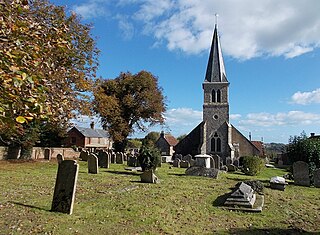
Yarmouth is a town, port and civil parish in the west of the Isle of Wight, off the south coast of England. The town is named for its location at the mouth of the small Western Yar river. The town grew near the river crossing, originally a ferry, which was replaced with a road bridge in 1863.

Freshwater is a large village and civil parish at the western end of the Isle of Wight, England. The southern, coastal part of the village is Freshwater Bay, named for the adjacent small cove. Freshwater sits at the western end of the region known as the Back of the Wight or the West Wight, a popular tourist area.

Newtown is a small village in the civil parish of Calbourne, Newtown and Porchfield, on the Isle of Wight, England. In medieval times it was a thriving borough.

Arreton is a village and civil parish in the central eastern part of the Isle of Wight, England. It is about 3 miles south east of Newport.

Ningwood is a village on the Isle of Wight. It is on several lanes about three miles east of Yarmouth in the northwest of the island. According to the Post Office to 2011 Census population of the village was included in the civil parish of Shalfleet. The Horse and Groom Pub is a prominent establishment in Ningwood, as is the Ningwood Bible Christian (Methodist) Chapel. Well-known island brickmakers, the Prichett family, established a brick yard in Ningwood in the 19th century.
Binstead is a village on the Isle of Wight. It is located in the northeast part of the Island, 1+1⁄2 miles (2.4 km) west of Ryde on the main road A3054 between Ryde and Newport. In the 2011 Census Binstead had been incorporated within Ryde whilst still retaining its electoral ward, Binsted and Fishbourne.

Totland is a village, civil parish and electoral ward on the Isle of Wight. Besides the village of Totland, the civil parish comprises the western tip of the Isle of Wight, and includes The Needles, Tennyson Down and the hamlet of Middleton.

Cranmore is a village on the Isle of Wight. It is located about three miles east of Yarmouth, in the northwest of the island. It is in the civil parish of Shalfleet.

Brook is a village and former civil parish, now in the parish of Brighstone, on the Isle of Wight, England. In 1931 the parish had a population of 156. On 1 April 1933 the parish was abolished and merged with Brighstone.

Shorwell is a village and civil parish on the Isle of Wight, United Kingdom. It is 4+1⁄2 miles (7.2 km) from Newport in the southwest of the island. Shorwell was one of Queen Victoria's favourite places to visit on the Isle of Wight.

Chale is a village and civil parish on the Isle of Wight of England, in the United Kingdom. It is located three kilometres from Niton in the south of the Island in the area known as the Back of the Wight. The village of Chale lies at the foot of St. Catherine's Down.

Calbourne is a village in the civil parish of Calbourne, Newtown and Porchfield, on the Isle of Wight, England. It is located 5 miles (8 km) from Newport in the west of the island.

Newbridge is a hamlet on the Isle of Wight. It is situated on a small hill, nine kilometres to the west of Newport on the western half of the island. According to the Post Office the 2011 Census population of the hamlet was included in the civil parish of Shalfleet.

Southern Vectis is a bus operator on the Isle of Wight. The company was founded in 1921 as "Dodson and Campbell" and became the "Vectis Bus Company" in 1923. The company was purchased by the Southern Railway before being nationalised in 1969. In 1987, the company was re-privatised. In July 2005, it became a subsidiary of Go-Ahead Group.

Lake is a large village and civil parish located on Sandown Bay, on the Isle of Wight, England. It is six miles south-east of Newport situated between Sandown and Shanklin, and 1+1⁄2 miles (2.4 km) to the east of the hamlet of Apse Heath.

Merstone is a hamlet on the Isle of Wight. It is home to Merston Manor, built in 1605 in the Jacobean style by Edward Cheeke, and rebuilt in the Victorian era. Merston Manor was first mentioned in the Domesday Book, and the present structure is arguably the oldest brick house on the Island. Prior to the Norman Conquest, Merston Manor was owned by the Brictuin family. The manor now belongs to the Crofts family. According to the Post Office the population of the hamlet was at the 2011 Census included in the civil parish of Arreton.

Northwood is a village and civil parish on the Isle of Wight. It lies south of the town of Cowes and has been occupied for about 1000 years. The Church of St. John the Baptist in Northwood, was first built between the 11th and 13th centuries.

Wightbus was a bus operator on the Isle of Wight, established and owned by the Isle of Wight County Council. It operated a network of thirteen local bus services running across the island, mostly services which would not have been viable for the island's dominant commercial operator, Southern Vectis, to operate.

Sandford is a hamlet on the Isle of Wight. Sandford is on the outskirts of Godshill in the southeast part of the island. Sandford has a latitude of 50°37′48.23″N1°13′45.63″W. Sandford is located on the A 3020 road and public transport is provided by bus route 2 and 3, run by Southern Vectis.





















